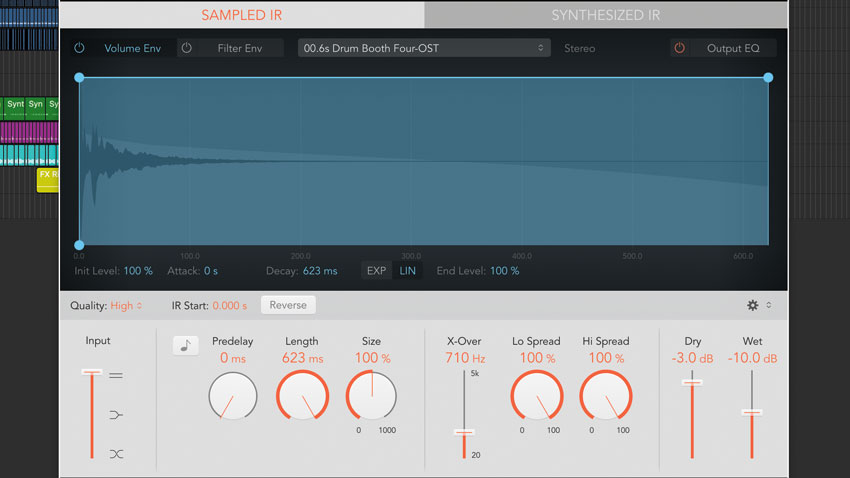8 ways to use reverb and delay to create super-stereo mixes
Take control of your stereo image using two of the most common effects around

When stereo width and/or interest are your goals, the first two effects you should be reaching for every time are are reverb and delay.
Between them, these two bread-and-butter processors present a wealth of creative possibilities when it comes to messing around with the stereo soundfield and the positioning of track elements within it. Here, we're going to look at eight of those possibilities, for you to put into practise in your own mixes as you see fit.
For more stereo mixing tips, get hold of the Autumn 2018 edition of Computer Music.

1. Mono reverb
Producers often use reverb as a creative tool for sound design. Virtual ambience can make a short sound lengthier and more characterful - almost like an extra oscillator! However, as almost all reverb signals are stereo, the timbre and character of your reverb may change dramatically in the mono downmix. A good approach, therefore, is to use mono reverb for ‘personality’ - this way, the reverb signal will stay completely consistent within the mix’s mid signal, and you can then process this mono reverb (perhaps with auto-panning, stereoisation or even further reverb!) to add extra stereo width to the ambience.
2. Reverb overheads
When mixing beats comprising disparate sound sources, you might send the entire drum bus to a single reverb in order to emulate the effect of drum kit overheads. Be aware that this will probably sound cool in stereo, but then disappear to some extent when summed to mono (see previous tip). Try monoing or narrowing reverbs when you need that to be tonally consistent in the mono mix – maybe pan or auto-pan it a bit to add a touch of width back in.

3. Stereo transients
Try to avoid having your most important transients (kick, snare, main hi-hat, etc) in the stereo signal - at least exclusively - otherwise your mono mix will lack power when those important attacks disappear. If you’re reverbing a snare, say, try automating the ’verb’s dry/wet mix to come up directly after that important transient. Flux’s BitterSweet plugin is a free transient processor that allows you to sculpt the mid or side signal’s attack and sustain independently - very useful when you want to, say, blunt a drum hit’s stereo transient.
4. Covert width
Stark, dry synths or drums signify an amateur mixdown. Apply very short reverb (or just the early reflections) to electronic drum hits, then tuck this stereo info under the dry signal to dial in natural-sounding reflections, like they’d have in a physical room. Keep the reverb extremely short for an almost imperceptible widening effect.
Get the MusicRadar Newsletter
Want all the hottest music and gear news, reviews, deals, features and more, direct to your inbox? Sign up here.
5. Separation vs glue
When we talk of mix ‘glue’, we all think of compression and saturation. But stereo processing can also tie things together - for better or worse! ‘Blanket’ stereo treatments on submixes can homogenise them in an unpleasant way, and lose separation… but that effect may be exactly what you want! Alternatively, go against common production rules and create separation by using a completely different reverb timbre for each element in your mix. Ultimately, this comes down to knowing when you want to ‘glue’ sounds with reverb or delay treatments, and when you want things separated.

6. A convoluted plan
Unlike algorithmic reverb, a convolution reverb plugin uses impulse responses ‘sampled’ from real spaces to generate virtual ambience. Many convolution reverb effects allow you to load up more unusual impulse responses, which can be used to give sounds a splash of weird, esoteric width.
7. Sampled reverb
Instead of calling up a reverb processor, hunt down a stereo sample (say, a reverbed clap) and use the sound’s baked-in ambience as a width-adding layer in the mix. This is especially useful when layering drum samples, as you can shape and pitch the ambience like any other sample.
8. Blowing up
Want to widen a narrow mix element? Try applying a coat of short stereo reverb or tight ping-pong delay, then load up a stereoising plugin and use it to exaggerate the width of the first effect. This way, you’ll be able to ‘blow up’ and magnify that extra width in a controlled fashion.
Computer Music magazine is the world’s best selling publication dedicated solely to making great music with your Mac or PC computer. Each issue it brings its lucky readers the best in cutting-edge tutorials, need-to-know, expert software reviews and even all the tools you actually need to make great music today, courtesy of our legendary CM Plugin Suite.










